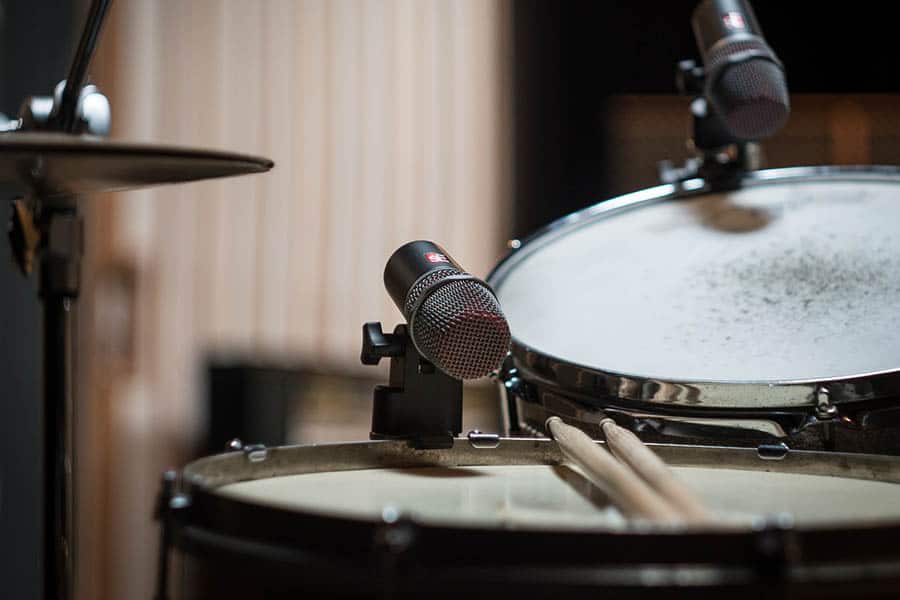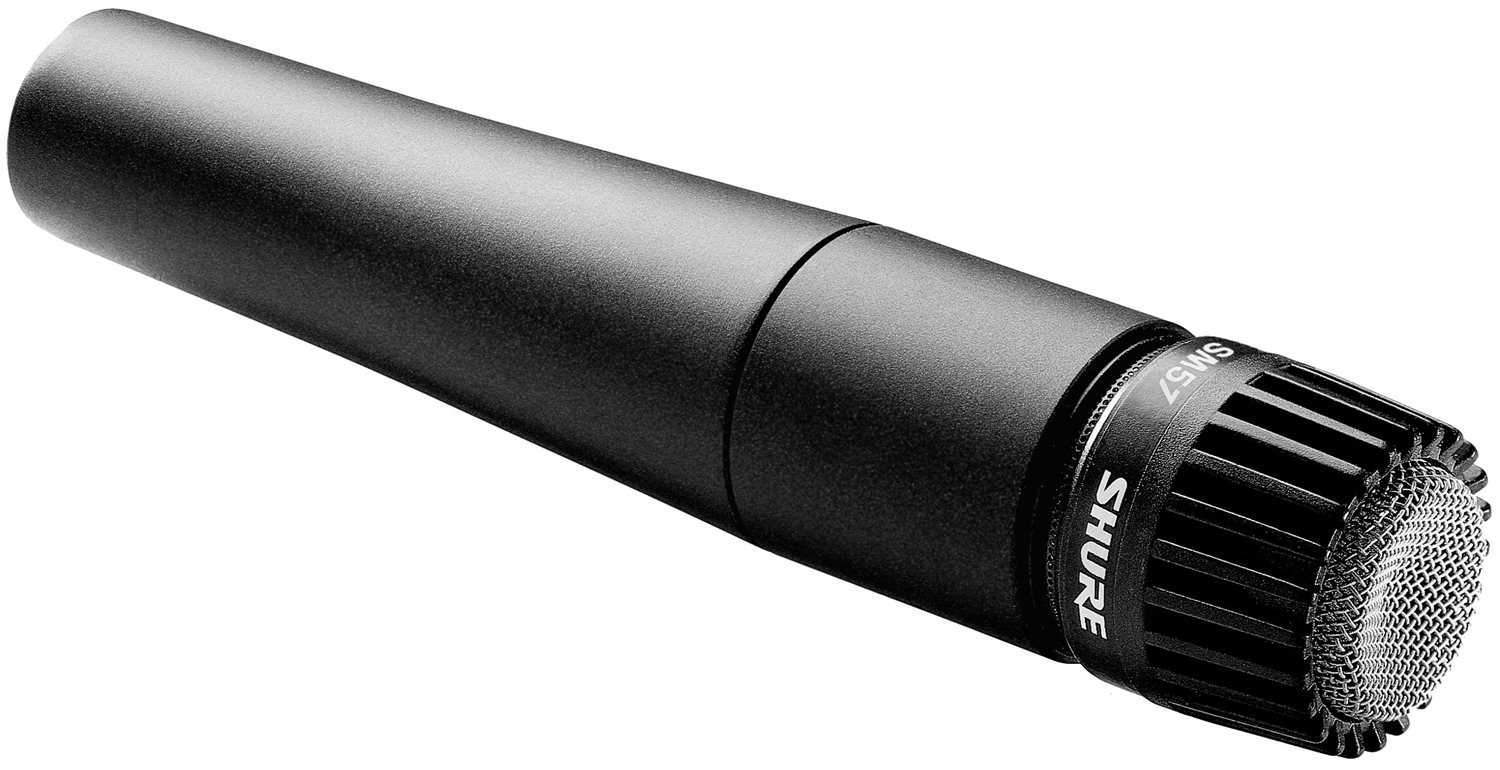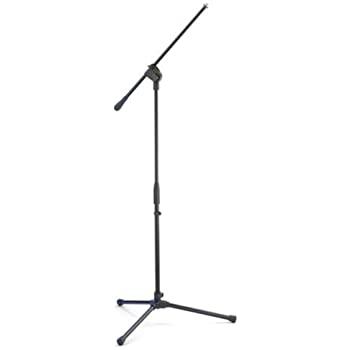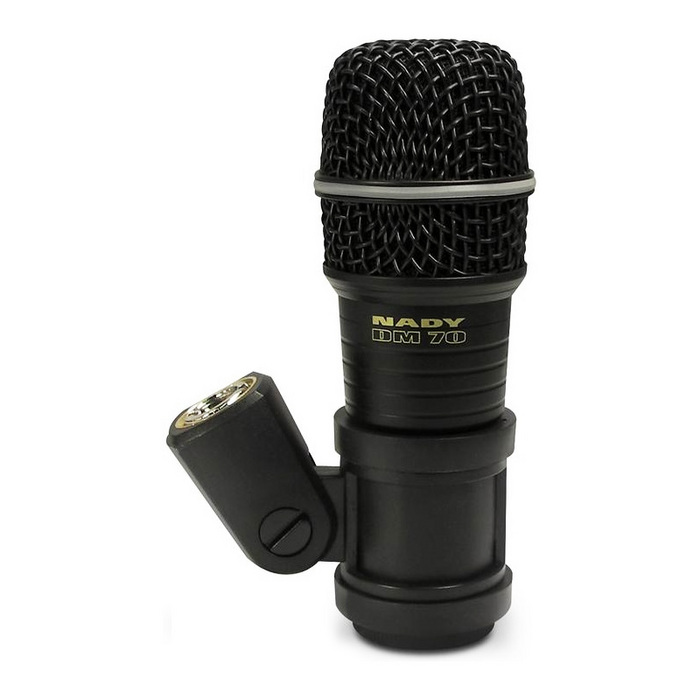
Best Budget Gear to Record Drums
How to Start Recording Drums on a Budget
Buy from AmazonWe receive a small kickback from our partners when you click through and purchase the great gear we recommend. Details
How to Start Recording Drums on a Budget
Best Budget Gear to Record Drums
- Don Makoviney
- Last Updated: September 27, 2020
The best audio gear to get a solid sound out of your drum kit for a fraction of the price.
Back in my band gigging days, we got to the point where we had enough material to actually start recording songs. Our only problem; we were broke college students.
Drums are one of the biggest challenges when it comes to recording. A whole kit is a big instrument and an absolute beast to mike up. We wanted to make this guide super straightforward so you can start recording for just a few hundred bucks. So, once you’ve got your computer and your DAW ready, make sure you keep in mind that there are lots of elements to take into consideration before you mike your kit and hit record.
Our favorite budget laptops to start producing audio
- Consider what you want each drum/cymbal to sound like
Being a broke college student meant our drummer didn’t even have the best drum kit to begin with. The crash sounded too tinny, the high hats didn’t line up properly, and her kick just sounded straight up BAD.
Take into consideration that you could always ask fellow drummer friends to borrow their gear for a day. I highly highly recommend this! It’s so much easier to mix drums if you already have a great recording to begin with. If you don’t have anything better you could get your hands on, improvise!
I remember one time we had to wrap a pair of headphones on top of the high hats in order for them to sound snappier and not ring out as much as they did. When we needed a damper snare sound, we just put a shirt over the top. I’ve found that over the years getting a specific drum sound honestly requires creativity in itself.
- Isolate each drum as much as possible
Drums are a tight compact unit with mic’s everywhere around it, so it is basically impossible to record without any microphone bleed. So how do you get around it?
You don’t.
But take precautions to get as little as possible! Make sure you have good acoustics, the right microphones, and adjust as needed. If you don’t have great acoustics, buy bass traps! If you’re really tight on cash, large thick mattresses and sofas have the same absorption properties of bass traps. Just make sure they’re near corners or any area of unnecessary sound reflection. Here are some of our tips on sound treating your space.
- Mic position is everything!
There are so many different techniques when it comes to recording drums. You have to be comfortable with the trial and error process. Sometimes I’ve recorded and mixed whole songs just to have to record the drums AGAIN because I needed the overhead to be slightly to the left more, or the snare mic got moved in the middle of the track and no one noticed. Little dumb things that are avoidable if you just pay attention, test the sound and actually listen to what sounds best.
Your ears know what sounds good and what doesn’t!
What Interface do I Need?
A lot of the time, people who record their stuff at home typically only have an interface that doesn’t have nearly enough inputs to record drums. I know I did!
Recording drums with two inputs is possible, but definitely not ideal. But the tricky part is finding an interface that has four or more inputs for a low price. If you don’t have the money to drop a on a bigger interface, here are a couple of our favorite budget options at MSCGR:
BEHRINGER U-PHORIA UMC404-HD

I literally love this thing. I got mine for 100 bucks at the time and I was actually blown away by the quality. It’s a solid hunk of metal with 48v, MIDI in and out, and 4 XLR and ¼ inch inputs. The driver is straightforward to download and set up, any dummy could figure out how to use this thing.
U-Phoria UMC404-HD on Guitar Center
This is our budget pick with the most inputs, but check out our other favorite interfaces.
Our favorite interface for recording a whole band!
YAMAHA MG10XU 10 Input Stereo Mixer

This thing’s great. I’ve actually messed with mine a lot over the past year. Besides it having multiple channel recording capabilities, it makes jam sessions or band practices much more organized.
It has plenty of channels for you to record drums, including 4 XLR inputs. A big plus to this mixer is that it grows with your band. Maybe down the road if you all wanted to run everything through a PA system, you’d be able to adjust everyone’s levels at your fingertips. It’s effective and versatile and CHEAP!
Budget Friendly Drum Microphones
So you’ve got the interface with enough inputs for all the microphones but you don’t even have enough microphones!
Like I said, recording drums requires a lot of trial and error and at the end of the day, your ears know what sounds good and what doesn’t. Maybe you like your $20 vocal mic enough to get a decent sound out of the snare with it. If it works, it works!
But here is some of our favorite drum microphones for cheap:
SHURE SM-57 $99

Kick/Snare/Cymbals/Toms
Quite possibly one of the best microphones of all time, the Shure SM-57 is a classic that you will never ever regret purchasing. It’s a dynamic microphone so it’s especially great for drums because it isolates sound so you get minimal bleed from other drums. This thing sounds great on any drum honestly. Try it out and you’ll agree!
NADY DM 70 $30

Kick/Floor Tom
I get really excited talking about these Nady microphones because they are seriously efficient little buggers. When I started recording I was trying to figure out which of my microphones I liked best on the kick and was seriously struggling. All my condensers had way too much bleed from the other drums and my other dynamics weren’t getting the sound I wanted (besides my SM-57, but I only had one at the time and it was on my snare!).
These little mikes are great because they’re built for low end drums. They’re also so cheap that I don’t mind bringing them to live shows to mic up a kit or let other people handle/borrow them. You will not be able to find a better kick/floor tom mic for a better price, I promise you.
One Amazon reviewer talked about how durable this little guy is;
“The artist I work for uses a floor Tom during his set and pours beer on it while he’s hitting it. So the fact this mic gets soaked in beer every gig and still works good says a lot.”
SAMSON C02 PENCIL CONDENSER MICROPHONES $140

Overheads/Cymbals
I know, I know. $140 is a lot to spend but take into consideration that you’re getting TWO condenser microphones, not just one.
So why do you need overhead microphones? Wikipedia puts it well:
“Overhead microphones are those used in sound recording and live sound reproduction to pick up ambient sounds, transients and the overall blend of instruments. They are used in drum recording to achieve a stereo image of the full drum kit.”
Having a good set of overhead mics is going to take your recordings to the next level. Some producers base their whole drum sound around the overheads, because overheads are meant to capture the entire atmosphere of the drums.

Some of our other overhead favorites at MSCGR
There are a lot better microphones to get for slightly more, and you can find some of our favorite kick, snare, tom, and high hat microphones on our site. However, we’re taking into consideration that these are the cheapest and best options out there to get you started.
Where do I Put All These Microphones?
So you’ve got everything you need but have no idea where to put these mikes. We understand the intimidation of finally starting to record drums but like we said; don’t be afraid of the trial and error process. You’re going to discover certain things just sound better if you do it a specific way. At the end of the day, trust your ears! If you think it sounds great, then it probably does!
There are A LOT of different techniques when it comes to recording drums. There are a handful of ways to mic up each drum. Consider if you want your snare miked from the top, the bottom, or the side. Do you want your kick mic inside the drum head or outside of it? What type of pattern do you want your overheads?
Here’s a great article about different ways you could mic each individual drum.
We can’t really tell you there’s a “right way” you should record your drum kit. Take the sound your going for into consideration and go from there.
I’m Ready to Start Recording!
A phrase I try to stay away from saying is “we’ll fix it in post.”
If any type of problem arises while recording (especially drums) fix it BEFORE you mix it. Do some practice runs and just listen. It should sound close to what you want the final mix to sound like. Drums are one of the hardest things to mix because there is a lot of bleed and a lot of microphones to take into consideration.
Set up sound panels! Make sure you have the right acoustics in the room you’re recording in. Put the kit on a rug, surround it with blankets, purchase bass traps, etc. Consider doing it in the living room between two sofas, but for the love of God; don’t think you can just “fix it in post.” If you don’t love the initial raw recordings, chances are you’re not even gonna like it after you mix it and have had to listen to it 1000 times.
Make sure you’ve got enough cables and mic stands and start recording!
Good luck 🙂
Tell Me If There's A Deal For This
How to Start Recording Drums on a Budget
Best Budget Gear to Record Drums

Important Specs
No Tech Specs Yet
Synopsis:
Recording drums can be intimidating when you're first starting out and don't have the proper funds. At MSCGR, we know you can get quality sounds for a low price. Here are some of our budget friendly options that we LOVE to start recording your drum kit.
No Rows Found

Best Overhead Sound
Samson C02 Condenser Microphone Pair
For all your overhead needs. The best way to capture the atmosphere of your entire drum kit.

The Universal Choice
Shure SM 57
The ultimate mic. Sounds great on everything!

Budget Mic Stand
Samson Microphone Stand
Our favorite budget friendly stand. You'll need a handful of microphone stands for all those drum mics!

For the Low Drums
Nady DM 70
This little guy is a ridiculous bargain! Nady's DM 70 holds up great over time and captures the low frequencies of your kit beautifully.
Sources
-
, Wikipedia, 20190923
Overhead Microphone“Overhead microphones are those used in sound recording and live sound reproduction to pick up ambient sounds, transients and the overall blend of instruments.[1] They are used in drum recording to achieve a stereo image of the full drum kit,[”
-
Christopher Darlington, Amazon, 20200119
Amazon Reviews“Clip broke pretty quick but the mic has been holding up well. The artist I work for uses a floor Tom during his set and pours beer on it while he’s hitting it. So the fact this mic gets soaked in beer every gig and still works good says a lot.”
Important Specs
No Tech Specs Yet
Follow MSCGR
Talk To Us
Did we miss a recommendation? Is there something you'd like to see us review? Typos? Mistakes? If so, drop us a line.
